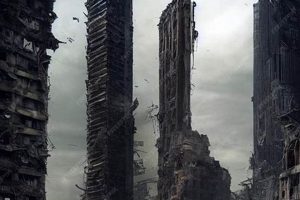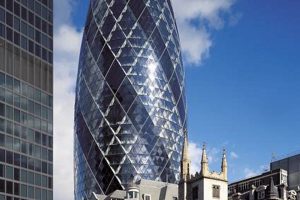New York City skyscrapers are some of the most iconic and recognizable buildings in the world. They are a symbol of the city’s financial and economic power, and they have played a major role in the development of the city’s skyline. The first skyscraper in New York City was the Equitable Life Building, which was completed in 1873. Since then, hundreds of other skyscrapers have been built in the city, including the Empire State Building, the Chrysler Building, and the One World Trade Center.
Skyscrapers have had a significant impact on the way that people live and work in New York City. They have allowed businesses to centralize their operations in a single location, and they have made it possible for people to live and work in close proximity to each other. Skyscrapers have also helped to create a sense of community in the city, as they have become landmarks that people can identify with.
The construction of skyscrapers in New York City has also had a significant economic impact on the city. The construction of these buildings has created jobs and stimulated the economy. Skyscrapers have also helped to attract tourists to the city, and they have become a major part of the city’s tourism industry.
1. Height
The height of New York City skyscrapers is a defining characteristic that sets them apart from buildings in other cities. The first skyscrapers were built in the late 19th century, and they quickly became a symbol of the city’s economic and financial power. Today, New York City is home to some of the tallest buildings in the world, including the Empire State Building, the Chrysler Building, and One World Trade Center.
- Structural Innovation: Skyscrapers require innovative engineering techniques to withstand the forces of wind and gravity. These buildings often feature reinforced concrete cores and steel frameworks that allow them to reach great heights.
- Vertical Communities: Skyscrapers create vertical communities, where people live and work in close proximity. This can lead to a sense of community and shared space.
- Urban Planning: The construction of skyscrapers has had a significant impact on urban planning in New York City. Zoning regulations have been put in place to control the height and density of buildings, and skyscrapers have helped to shape the city’s skyline.
- Economic Impact: Skyscrapers are a major economic driver for New York City. They attract businesses and tourists from around the world, and they generate billions of dollars in revenue each year.
The height of New York City skyscrapers is a testament to the city’s economic power and its commitment to innovation. These buildings are a major part of the city’s identity, and they continue to attract people from all over the world.
2. Architecture
The architecture of New York City skyscrapers is as diverse as the city itself. From the Art Deco towers of the 1920s to the modernist skyscrapers of the 1950s and 1960s, these buildings reflect the changing tastes and technologies of their time.
Art Deco skyscrapers are characterized by their sleek lines, geometric shapes, and decorative details. Some of the most famous examples of Art Deco skyscrapers in New York City include the Chrysler Building, the Empire State Building, and the Rockefeller Center.
Modernist skyscrapers are characterized by their simple lines, lack of ornamentation, and use of glass and steel. Some of the most famous examples of modernist skyscrapers in New York City include the Seagram Building, the Lever House, and the United Nations Secretariat Building.
The diversity of architectural styles in New York City skyscrapers is a reflection of the city’s status as a global center of commerce and culture. These buildings are not only symbols of the city’s economic power, but also of its creative spirit.
3. Engineering
The engineering behind New York City skyscrapers is a marvel of human ingenuity. Innovative techniques have allowed these buildings to reach unprecedented heights and withstand the forces of nature.
One of the most important engineering innovations that made skyscrapers possible is the development of the steel frame. Steel frames are lightweight and strong, and they can be used to create buildings that are much taller than buildings made of traditional materials such as stone or brick.
Another important engineering innovation is the development of the elevator. Elevators make it possible for people to easily reach the upper floors of skyscrapers. Without elevators, skyscrapers would not be practical, as people would have to climb stairs to reach their offices or apartments.
In addition to steel frames and elevators, skyscrapers also rely on a variety of other engineering innovations, such as reinforced concrete, wind turbines, and seismic dampers. These innovations have made it possible to build skyscrapers that are safe, efficient, and sustainable.
The engineering of New York City skyscrapers is a testament to the creativity and ingenuity of human engineers. These buildings are a symbol of the city’s economic power and its commitment to innovation.
4. Economic Power
Within the context of “ny skyscraper”, the economic power and prosperity that these architectural marvels represent play a significant role. Skyscrapers have been inextricably linked to the financial and economic development of New York City, serving as emblems of its economic vitality and global influence.
- Icons of Financial Dominance: Skyscrapers have become synonymous with the financial prowess of New York City. The presence of towering skyscrapers, particularly in the iconic Wall Street district, symbolizes the city’s status as a global financial hub. The height and grandeur of these buildings convey a sense of power and economic dominance, reinforcing the city’s position as a leading center of finance and banking.
- Drivers of Economic Growth: The construction and maintenance of skyscrapers have a substantial impact on the city’s economy. The development of these vertical structures creates numerous job opportunities in various sectors, including construction, engineering, architecture, and real estate. Moreover, skyscrapers attract businesses and corporations from around the world, further stimulating economic growth and investment in the city.
- Symbols of Technological Advancement: Skyscrapers embody the cutting-edge technol
ogical advancements that have shaped the construction industry. The innovative engineering and architectural techniques employed in their design and construction push the boundaries of human ingenuity. These buildings showcase the latest advancements in materials, structural systems, and sustainable technologies, contributing to the city’s reputation as a hub of innovation and progress. - Monuments of Cultural Significance: Beyond their economic significance, skyscrapers have become iconic landmarks and cultural symbols of New York City. The Empire State Building, the Chrysler Building, and One World Trade Center are recognized worldwide and have featured prominently in popular culture. These skyscrapers have transcended their functional purpose and have become ingrained in the city’s identity, attracting tourists and contributing to its vibrant cultural landscape.
In conclusion, the connection between “Economic Power: Skyscrapers serve as symbols of financial strength and economic prosperity” and “ny skyscraper” is deeply intertwined. Skyscrapers stand as testaments to the economic vitality, technological prowess, and cultural significance of New York City. Their presence continues to shape the city’s skyline and reinforce its position as a global economic powerhouse and a hub of innovation and cultural influence.
5. Urban Planning
The connection between urban planning and New York City skyscrapers is profound. Skyscrapers have had a significant impact on the way that the city has been planned and developed, and they have also influenced zoning regulations that govern the construction of new buildings.
One of the most important ways that skyscrapers have influenced urban planning is by creating a need for zoning regulations. In the early 20th century, as skyscrapers began to proliferate in New York City, there was growing concern about the negative effects that these buildings could have on the city’s environment and quality of life. In response to these concerns, the city passed a series of zoning laws that regulated the height, bulk, and use of buildings in different parts of the city.
Zoning regulations have played a major role in shaping the urban landscape of New York City. They have ensured that skyscrapers are constructed in a way that is compatible with the surrounding environment, and they have also helped to preserve the city’s historic character. Zoning regulations have also been used to promote affordable housing and to create more open space in the city.
The relationship between urban planning and skyscrapers is a complex one. However, it is clear that these two forces have worked together to shape the development of New York City. Zoning regulations have helped to ensure that skyscrapers are constructed in a way that is compatible with the surrounding environment and that they contribute to the overall quality of life in the city.
6. Cultural Impact
The connection between skyscrapers and cultural impact is undeniable. New York City skyscrapers have become iconic landmarks, deeply ingrained in popular culture and globally recognized, shaping the city’s identity and contributing to its allure.
- Symbols of the City’s Identity: Skyscrapers have become synonymous with New York City, their towering presence defining the city’s skyline and serving as instantly recognizable symbols. The Empire State Building, the Chrysler Building, and One World Trade Center are just a few examples of skyscrapers that have become cultural icons, representing the city’s ambition, innovation, and resilience.
- Backdrops for Cultural Expression: Skyscrapers have provided a captivating backdrop for countless works of art, literature, and film. From the classic King Kong scaling the Empire State Building to the romantic encounters atop the Rockefeller Center, skyscrapers have played a central role in shaping the cultural narrative of New York City.
- Tourist Attractions: New York City skyscrapers are major tourist destinations, attracting visitors from around the world. Observation decks, such as those at the Empire State Building and Top of the Rock, offer breathtaking views of the city, making skyscrapers not only architectural marvels but also popular tourist attractions.
- Global Recognition: The iconic status of New York City skyscrapers extends far beyond the city limits. They have become globally recognized symbols of American architecture and engineering prowess. Their presence in popular culture and media has further cemented their place in the global consciousness, making them instantly recognizable landmarks.
In conclusion, the cultural impact of New York City skyscrapers is undeniable. They have become ingrained in popular culture, serving as symbols of the city’s identity, providing backdrops for cultural expression, attracting tourists, and gaining global recognition. Their iconic status is a testament to their architectural significance and their enduring presence in the hearts and minds of people worldwide.
7. Sustainability
The connection between sustainability and New York City skyscrapers is growing as modern buildings prioritize eco-friendly designs and energy efficiency. This focus on sustainability stems from several factors, including environmental concerns, economic benefits, and government regulations.
Environmental concerns have driven the demand for sustainable skyscrapers. The construction and operation of buildings account for a significant portion of greenhouse gas emissions, and skyscrapers, with their massive size and energy needs, have a substantial impact on the environment. As a result, architects and developers are increasingly designing skyscrapers that minimize their environmental impact.
Economic benefits also play a role in the push for sustainable skyscrapers. Energy-efficient buildings can significantly reduce operating costs, making them more attractive to tenants and investors. Additionally, sustainable skyscrapers can qualify for tax breaks and other incentives, further boosting their economic viability.
Government regulations are another factor driving the adoption of sustainable practices in skyscraper construction. New York City has implemented a number of green building codes and regulations, which require new buildings to meet certain energy efficiency standards. These regulations have helped to make sustainable skyscrapers the norm in the city.
Several notable examples of sustainable skyscrapers in New York City include:
- One World Trade Center: This iconic skyscraper is the tallest building in the Western Hemisphere and features a number of sustainable design elements, including a rainwater collection system and a green roof.
- Bank of America Tower: This skyscraper is one of the most energy-efficient buildings in the world, thanks to its use of natural light, passive ventilation, and a rainwater collection system.
- 432 Park Avenue: This ultra-luxury residential skyscraper features a number of sustainable design elements, including a high-performance curtain wall system and a green roof.
The focus on sustainability in New York City skyscrapers is
a positive trend that is helping to reduce the environmental impact of buildings and create a more sustainable city. As technology continues to improve and costs come down, sustainable skyscrapers will become even more common in the future.
8. Tourism
The connection between tourism and New York City skyscrapers is undeniable. Skyscrapers are a major tourist attraction, drawing visitors from around the world who come to admire their architectural beauty and enjoy the breathtaking views from their observation decks.
There are several reasons why skyscrapers are so popular with tourists. First, they are iconic landmarks that represent the city’s economic power and cultural significance. Visitors from all over the world come to New York City just to see these amazing structures up close. Second, skyscrapers offer stunning views of the city. Observation decks, such as those at the Empire State Building and Top of the Rock, provide visitors with panoramic views of the city’s skyline, landmarks, and surrounding areas. Third, skyscrapers are often home to world-class restaurants, shops, and entertainment venues. This makes them a convenient and enjoyable place for tourists to spend an afternoon or evening.
The tourism industry in New York City benefits greatly from the city’s skyscrapers. Tourists spend billions of dollars each year on hotels, restaurants, shops, and other businesses. This spending helps to support the city’s economy and create jobs. In addition, tourism helps to promote New York City as a global destination and cultural hub.
Here are some examples of how skyscrapers have been used to attract tourists to New York City:
- The Empire State Building is one of the most popular tourist attractions in the world. Visitors can take an elevator to the observation deck, which offers stunning views of the city.
- Top of the Rock is another popular observation deck, located at the top of Rockefeller Center. Visitors can enjoy panoramic views of the city, including Central Park, the Empire State Building, and the Hudson River.
- One World Observatory is located at the top of One World Trade Center, the tallest building in the Western Hemisphere. Visitors can take an elevator to the observation deck, which offers 360-degree views of the city.
The connection between tourism and New York City skyscrapers is a mutually beneficial one. Skyscrapers attract tourists to the city, and tourists help to support the city’s economy. As a result, skyscrapers are an important part of the city’s tourism industry and play a vital role in the city’s overall economic development.
9. Community
In the context of “ny skyscraper,” the connection between skyscrapers and community is significant. Skyscrapers, with their towering height and multiple floors, have the potential to create vertical communities where residents and workers share a sense of belonging and common space. This aspect of skyscrapers contributes to the overall livability and social fabric of New York City.
One way that skyscrapers foster a sense of community is through the creation of shared amenities and spaces. Many skyscrapers have ground-floor retail, restaurants, and public plazas that serve as gathering places for residents and workers. These spaces provide opportunities for people to interact and connect with each other, fostering a sense of community beyond individual apartments or offices.
Additionally, skyscrapers often have residential units with balconies or terraces, which provide private outdoor spaces for residents. These spaces allow residents to enjoy the outdoors and interact with their neighbors, further strengthening the sense of community within the building.
The vertical nature of skyscrapers also contributes to a sense of shared space and community. Unlike traditional low-rise buildings, skyscrapers bring people together from different backgrounds and walks of life, creating a diverse and vibrant community within a single structure.
The community aspect of skyscrapers is not only beneficial for the residents and workers within the building but also for the city as a whole. Vertical communities can help to reduce isolation and loneliness, particularly in a dense urban environment like New York City. They can also promote social cohesion and a sense of place, contributing to the overall well-being and vitality of the city.
In conclusion, the connection between “Community: Skyscrapers create vertical communities, fostering a sense of belonging and shared space.” and “ny skyscraper” is an important one. Skyscrapers have the potential to create vibrant and diverse communities within their walls, contributing to the social fabric and livability of New York City.
FAQs on New York City Skyscrapers
Skyscrapers have become iconic symbols of New York City’s skyline and economic power. Here are answers to some frequently asked questions about these architectural marvels:
Question 1: What is the tallest skyscraper in New York City?
One World Trade Center, standing at 1,776 feet tall, is currently the tallest skyscraper in New York City.
Question 2: What was the first skyscraper in New York City?
The Equitable Life Building, completed in 1873, is widely recognized as the first skyscraper in New York City.
Question 3: How many skyscrapers are there in New York City?
There are over 6,000 skyscrapers in New York City, more than any other city in the world.
Question 4: What is the most famous skyscraper in New York City?
The Empire State Building is arguably the most famous skyscraper in New York City, known for its iconic Art Deco style and observation deck.
Question 5: How tall do skyscrapers need to be to be considered a skyscraper?
There is no universally accepted height requirement for a building to be considered a skyscraper. However, most definitions start at around 150 meters (492 feet) tall.
Question 6: Are skyscrapers safe?
Modern skyscrapers are designed to withstand high winds, earthquakes, and other potential hazards. They are generally considered safe, with advanced safety features and building codes in place to ensure the well-being of occupants.
These FAQs provide a brief overview of some common questions and answers related to New York City skyscrapers. For more in-depth information, please refer to specialized sources on architecture and urban planning.
Transition to the next article section:
The Impact of Skyscrapers on New York City’s Skyline and Economy
Tips for Visiting New York City Skyscrapers
Visiting New York City’s skyscrapers is a must-do experience for any visitor to the city. These iconic buildings offer breathtaking views, unique architectural experiences, and a glimpse into the city’s rich history.
Here are five tips to make the most of your visit:
Tip 1: Choose the right skyscraper.
There are many skyscrapers to choose from in New York City, each with its own unique features. Do some research to find one that interests you, whether it’s the Empire State Building for its iconic status, the One World Trade Center for its stunning views, or the Chrysler Building for its Art Deco architecture.
Tip 2: Purchase tickets in advance.
Tickets to New Yo
rk City skyscrapers can sell out quickly, especially during peak season. To avoid disappointment, purchase your tickets online in advance. This will also allow you to skip the lines and go straight to the elevator.
Tip 3: Arrive early.
Even if you have purchased tickets in advance, it’s a good idea to arrive early to allow for security checks and to avoid crowds. This will give you plenty of time to enjoy the views and take some photos.
Tip 4: Take your time.
Don’t rush your visit to the top of a skyscraper. Take your time to enjoy the views and soak in the experience. There are often exhibits and interactive displays that provide information about the building and its history.
Tip 5: Bring a camera.
The views from New York City skyscrapers are incredible, so don’t forget to bring a camera to capture the moment. You’ll want to remember the breathtaking sights you see from the top of these iconic buildings.
By following these tips, you can make the most of your visit to New York City skyscrapers. These architectural marvels offer a unique and unforgettable experience that will leave you with lasting memories.
Transition to the article’s conclusion:
New York City skyscrapers are a must-see for any visitor to the city. By following these tips, you can make the most of your visit and enjoy the breathtaking views and unique experiences that these iconic buildings have to offer.
Conclusion
New York City skyscrapers are a testament to the city’s economic power, architectural prowess, and cultural significance. They have shaped the city’s skyline, influenced its urban planning, and become iconic landmarks recognized around the world. From the towering height of One World Trade Center to the Art Deco elegance of the Chrysler Building, these skyscrapers represent the ambition and innovation that have made New York City a global metropolis.
As we look to the future, skyscrapers will continue to play a vital role in the development of New York City. They will continue to be symbols of the city’s economic strength and cultural vitality, while also serving as hubs of innovation, sustainability, and community. By embracing new technologies and design principles, skyscrapers will continue to evolve and adapt to meet the changing needs of the city and its people.







